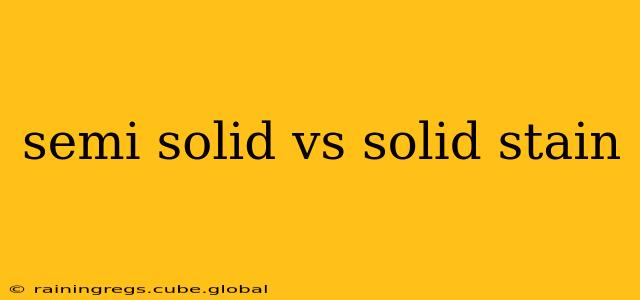Choosing between semi-solid and solid stains can feel overwhelming, especially with the wide array of options available at home improvement stores. This comprehensive guide will break down the key differences between these two popular wood stains, helping you select the perfect one for your next project. We'll cover everything from their appearance and application to their durability and best uses. By the end, you'll be confident in making an informed decision.
What is Semi-Solid Stain?
Semi-solid stain offers a happy medium between transparency and opacity. It provides more color coverage than a transparent stain but still allows some of the wood grain to show through. Think of it as a balance between highlighting the natural beauty of the wood and adding a rich, consistent color. The pigment concentration is higher than in a transparent stain, resulting in a more opaque finish. However, the level of opacity will vary depending on the brand and color chosen.
What is Solid Stain?
Solid stain, also known as solid color stain or opaque stain, provides complete color coverage, masking the wood grain almost entirely. It's essentially a paint that's designed to be applied to wood, offering a uniform, even color across the surface. This is ideal for projects where you want a bold, consistent color without the wood grain being a focal point. Solid stains can be used to dramatically change the color of the wood, even covering dark woods with light shades.
Semi-Solid Stain vs. Solid Stain: A Detailed Comparison
| Feature | Semi-Solid Stain | Solid Stain |
|---|---|---|
| Opacity | Partially opaque; wood grain shows through | Completely opaque; hides wood grain |
| Color Coverage | Moderate | Full |
| Wood Grain Visibility | Visible | Hidden |
| Durability | Moderate; requires more topcoats | High; often requires fewer topcoats |
| Application | Similar to transparent stains | Similar to paint |
| Best Uses | Furniture, cabinets, trim, decks (with proper sealant) | Furniture, cabinets, doors, fences |
| Maintenance | Requires more frequent maintenance | Less frequent maintenance |
How to Choose Between Semi-Solid and Solid Stain
The best choice depends entirely on your project and personal preference. Consider the following:
- Desired Appearance: Do you want the wood grain to be visible, or do you prefer a uniform, solid color? This is the most crucial factor.
- Wood Type: The type of wood will also influence your decision. A more porous wood may require a solid stain to achieve even color.
- Project Requirements: Some projects, like fences, benefit from the durability of solid stain, while others, like fine furniture, might require the more subtle look of a semi-solid stain.
What type of stain is best for exterior use?
For exterior applications like decks and fences, choosing between semi-solid and solid stain depends heavily on your desired look and the level of protection you need. Solid stains generally offer better protection against the elements, but both types require a quality exterior-grade sealant for long-lasting durability. Proper preparation of the wood surface is crucial regardless of your stain choice.
What type of stain is best for interior use?
For interior projects, both semi-solid and solid stains can work well. The choice depends on whether you want to showcase the wood grain or achieve a uniform color. Semi-solid stains are often preferred for furniture and cabinets where the natural wood grain adds character. Solid stains can be used to achieve dramatic color changes and create a more modern look.
How many coats of semi-solid stain do I need?
The number of coats needed will depend on the wood type, the stain's opacity, and the desired level of color saturation. Typically, two coats are sufficient, but some projects may benefit from a third coat for deeper color and better protection. Always follow the manufacturer's instructions for the best results.
Can I use semi-solid stain on my deck?
Yes, you can use semi-solid stain on your deck, but it's essential to apply a high-quality exterior-grade sealant afterward to protect it from the elements. Keep in mind that semi-solid stain may require more frequent maintenance and reapplication compared to solid stain due to its lower opacity.
By considering these factors and understanding the differences between semi-solid and solid stains, you can confidently select the right finish to bring your next woodworking project to life. Remember to always read the manufacturer's instructions carefully before starting your project.
